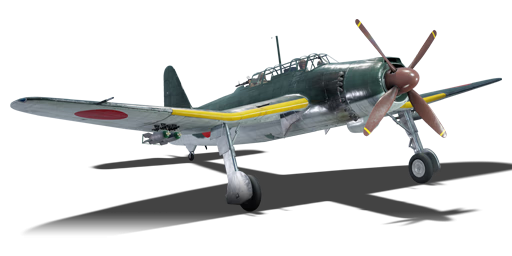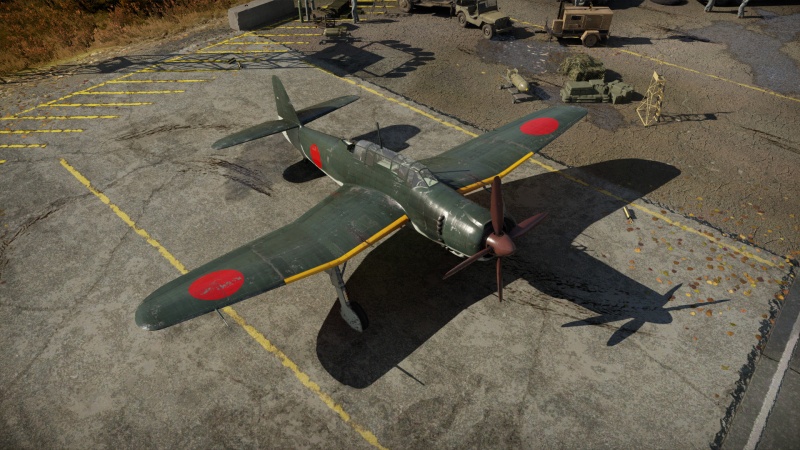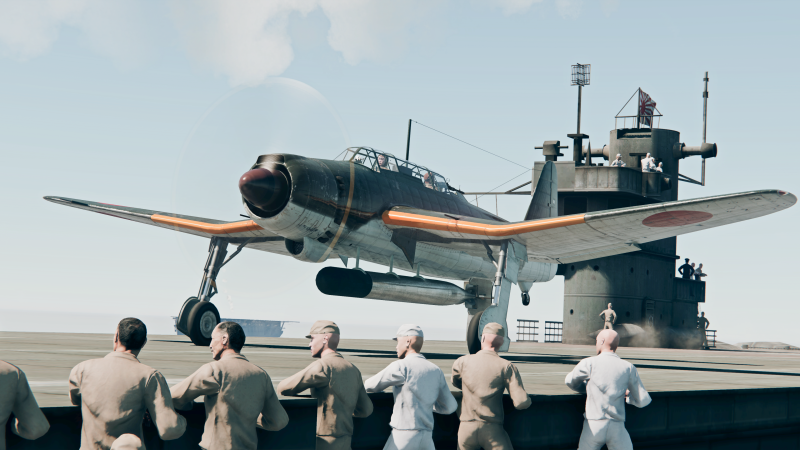B7A2
| This page is about the Japanese bomber B7A2. For the premium version, see B7A2 (Homare 23). |
Contents
Description
The B7A2 Ryusei was a carrier-borne torpedo-dive bomber developed by Aichi for the Imperial Japanese Navy Air Service during the Second World War. It was designed to replace the B6N Tenzan and the D4Y Suisei in the Navy's service. It had a mid-wing configuration with an inverted gull wing, a four-bladed propeller, and a bomb bay. It was powered by the Nakajima NK9C Homare 12 radial engine, which was expected to become the Navy's standard engine in its power range. The plane was intended to operate from the new Taihō-class carriers, which had larger deck elevators than the older carriers. The plane first flew in May 1942, but production was delayed by various problems with the engine and the airframe. Only 114 planes were built before the war ended. The plane saw limited action in the final stages of the war, mainly from land bases, and did not have much opportunity to demonstrate its potential.
The Ryusei was introduced in Update 1.37. While it looks like a rather large simple torpedo bomber, it is deceivingly manoeuvrable and fast for its vehicle class; this, however, is exchanged for a lack of armour. On top of that, it can bite back with its defensive 13 mm machine gun or engage frontally with two wing-mounted Type 99 Model 2 cannons. While technically classified as a carrier-borne torpedo bomber, it is very capable of fulfilling the roles of dive-, level-, and torpedo bombing targets. While the max tonnage of bombs doesn't increase over the previous B6N Tenzan, it can carry four additional wing-mounted 60 kg bombs next to its bomb bay that can load two 250 kg or six 60 kg bombs. The main playstyle of the B7A2 is more like an unarmoured attacker, using its arsenal of bombs and cannons on targets either in the sky, on the ground, or on the sea with the deadly precision of its gyrostabilized dive-bomber sight.
- Nicknames
- Official Designation: 流星 (Ryūsei, "Shooting Star")
- Allied reporting name: Grace.
General info
Flight performance
The B7A2 "Ryusei" represents a significant advancement in the Japanese Navy's multi-role bomber design, surpassing not only its predecessor, the B6N "Tenzan", but also assuming the dive-bomber duties previously assigned to the D4Y "Suisei". Featuring a distinctive gull-wing design, internal bomb bay, and offensive armament, the Ryusei marks a notable departure from its predecessors, notably by eliminating the need for a third crew member, with navigational duties now assumed by the rear gunner.
While these innovations by Aichi resulted in a somewhat heavier and bulkier aircraft, the engine configuration remains largely unchanged, with the Nakajima Homare 12 delivering 1,831 hp at takeoff. This stands in contrast to the lighter Tenzan, powered by the Mitsubishi Kasei 25 engine with 1,826 hp takeoff power. Consequently, the Ryusei exhibits a slower acceleration and somewhat sluggish performance at low speeds. Moreover, the efficient cooling system ensures that overheating is not a concern even under sustained WEP usage which can be used without limit.
One significant flaw in the manoeuvrability of the Ryusei is its roll rate. While its turn rate, rudder, and elevator authorities are relatively fine, the roll rate is notably stiff. Pilots need to be aware of this characteristic. Simply rolling out of combat is not a straightforward manoeuvre, and to leverage its commendable turn rate, the initiation of the roll should be done as early as possible.
The B7A2's manoeuvrability and acceleration are notably weak when operating below 300 km/h. However, as its speed increases between 300 and 500 km/h, the Ryusei demonstrates impressive agility, often outperforming enemy fighters in turns. With the added boost of WEP, it maintains energy well during manoeuvres, allowing it to effectively pursue adversaries.
Nevertheless, as the Ryusei's velocity surpasses 500 km/h, it begins to experience a gradual loss of control, eventually leading to lockup around 600 km/h. This limitation poses risks, particularly during dive-bombing missions, where failed pull-ups can be fatal. Fortunately, the aircraft's airbrakes offer a solution by restoring control and facilitating safe recovery from dives.
| Characteristics | Max Speed (km/h at 6,550 m) |
Max altitude (metres) |
Turn time (seconds) |
Rate of climb (metres/second) |
Take-off run (metres) | |||
|---|---|---|---|---|---|---|---|---|
| AB | RB | AB | RB | AB | RB | |||
| Stock | 542 | 525 | 8260 | 28.8 | 29.6 | 7.3 | 7.3 | 270 |
| Upgraded | 594 | 565 | 26.7 | 28.0 | 17.7 | 10.4 | ||
Details
| Features | ||||
|---|---|---|---|---|
| Combat flaps | Take-off flaps | Landing flaps | Air brakes | Arrestor gear |
| ✓ | ✓ | ✓ | ✓ | ✓ |
| Limits | ||||||
|---|---|---|---|---|---|---|
| Wings (km/h) | Gear (km/h) | Flaps (km/h) | Max Static G | |||
| Combat | Take-off | Landing | + | - | ||
| 680 | 350 | 457 | 428 | 280 | ~15 | ~15 |
| Optimal velocities (km/h) | |||
|---|---|---|---|
| Ailerons | Rudder | Elevators | Radiator |
| < 380 | < 380 | < 450 | > 312 |
Survivability and armour
- 13 mm steel plate in the nose
- Fuel tanks are not self-sealing (3 in each wing)
Although the B7A2's airframe is fairly durable, the pilot and gunner is exposed to an attack from any angle except frontally due the lack of bulletproof glass and armour. As the Ryusei lacks any self-sealing fuel tank, fire damage will be a death sentence for the plane.
Modifications and economy
Since the B7A2 is a multi-role aircraft any module research path is viable. Unlocking performance modules will boost survivability and damage potential in dogfights, whereas unlocking armament modules will help with the ground attack. Some of the best modules to unlock are the "Engine injection" and "Offensive 20 mm belts".
Armaments
Offensive armament
The B7A2 is armed with:
- 2 x 20 mm Type 99 Model 2 cannons, wing-mounted (200 rpg = 400 total)
Suspended armament
The B7A2 can be outfitted with the following ordnance:
- 10 x 60 kg Navy Type 97 Number 6 bombs (600 kg total)
- 2 x 250 kg Navy Type 98 Number 25 bombs + 4 x 60 kg Navy Type 97 Number 6 bombs (740 kg total)
- 1 x 800 kg Number 80 Mod. 1 bomb (800 kg total)
- 1 x 850 kg Type 91 Model 3 torpedo
Defensive armament
The B7A2 is defended by:
- 1 x 13 mm Type 2 machine gun, dorsal turret (1,000 rpg)
Usage in battles
The Ryusei is best utilized as a multi-role aircraft, similar to the role the Ju 87 D-5 plays. Once its payload is dropped, the B7A2 becomes a low altitude, low-speed dogfighter similar to an A6M. In realistic battles, the B7A2 is often paired with aircraft such as the A6M3, A6M3 mod. 22, and A6M3 mod. 22Ko. If unable to shake an enemy off your tail, these "Zeroes" can be relied on as they have impressive low altitude capabilities.
Payload choice is dependent on target choice. If the target is a light pillbox, for instance, one does not need an 800 kg bomb. Instead, equip either of the other bomb loadout options. The same goes for most ground units, apart from arcade mini bases. The Ryusei is similar to aircraft such as the Ki-49-IIa in that it can "hover" above an enemy base or airfield, rapidly dropping its payload and diving up to altitude again. Since the B7A2 is a dive bomber, it does not have to be level to drop its payload accurately. The Ryusei's ability to "hover" above enemy mini bases and airfields can be a great help to any arcade battles team. Upgrading the crew reload speed makes this aircraft a potential game-winner, especially when in a squad.
Similar to the Ju 87 D-5, the Ryusei's airspeed is not on par with the aircraft it faces, no matter the game mode. This handicaps the B7A2 to playing solely a support role, only being able to engage the aircraft it can catch. Nonetheless, having a B7A2 on any team, no matter the game mode, never hurts.
Manual Engine Control
| MEC elements | ||||||
|---|---|---|---|---|---|---|
| Mixer | Pitch | Radiator | Supercharger | Turbocharger | ||
| Oil | Water | Type | ||||
| Controllable | Controllable Not auto controlled |
Controllable Auto control available |
Controllable Auto control available |
Separate | Controllable 2 gears |
Not controllable |
Pros and cons
Pros:
- B7A for Carrier-based torpedo bomber
- Bomber spawn
- 1 x Type 91 Aerial Torpedo
- Torpedo has the highest drop speed in the game at 580 km/h and is one of the most feared torpedoes in Naval Battles
- 10 x Type 97 No.6 Land Bomb (60kg)
- Gets a bomb bay of 6 x 60 kg bombs which can be used to hit multiple targets (+4 on the wings that drop in pairs)
- 1 x No.80 Land Bomb (800 kg)
- Heaviest bomb Japanese Navy can offer
- Common Navy plane construction:
- Excellent manoeuvrability
- B7A2 specific
- Airbrakes
- Short take-off and landing distance
- 2 x wing mounted Type 99 Model 2 (20 mm)
- 1 x tail defensive Type 2 (13 mm) with good coverage
Cons:
- B7A for Carrier-based torpedo bomber
- Relatively Large target
- Common Navy plane construction:
- Little armour, and no self-sealing fuel tanks
- Exposed tail gunner
- Easily compress when exceeding 600 km/h
- Mediocre roll rate
- Limited WEP time (only 5 minutes 20 seconds of water injection)
History
Two-seat carrier-based Aichi B7A2 Ryusei "Shooting Star" or "Meteor" Torpedo/Dive Bomber (Allied reporting name: Grace). The B7A was an answer to a specification for a carrier-based torpedo/dive bomber in 1941. It was intended to replace B6N and D4Y, having an internal and external payload, increased speed and long-range. Some of the design features of the B7A include; inverted gull-wings, conventional fuselage, and tail unit and a four-bladed propeller. During its development, it went through a series of shortcomings, such as the delivery of engines, and an accidental earthquake which destroyed the main factory housing most of the B7As. Thus not seeing active service until 1944. By this time, there were no aircraft carriers capable of operating the B7A. The last aircraft carrier being the Shinano was sunk 10 days after its commission. The B7A2 was then forced to operate in home defence operations, seeing limited service.
Known as the AM-23 within Aichi, the first prototype was completed and flown in May 1942 which was designated the B7A1 by the Navy. The B7A used the Nakajima NK9C 12 Model radial engine, producing 1,825 hp. This gave the aircraft exceptionally good speed, even when fully loaded with ammunition and bombs. During flight testing, the Navy was very impressed with its performance. Despite it being a very large light bomber, the B7A1 displayed handling and performance comparable to the Mitsubishi's A6M Zero and a further 8 prototypes were ordered. However, with more testing underway, it was noted that the engine (which was experimental as well) suffered teething problems, and the airframe of the aircraft needed modifying structurally. It was not until two years later that the B7A would begin production in 1944.
Up until May 1945, 80 B7A2s had been completed. But soon after, a severe earthquake occurred, destroying the factory housing the aircraft that were being assembled. A further 25 more examples were completed by another factory. Throughout the B7A2's service, different variants were planned. Firstly, was an experimental production B7A2, that was fitted with the Nakajima Homare 23 radial engine, producing 2,000 hp. Only 1 was built. Secondly, came the B7A3 Ryusei-Kai. This was to use the Mitsubishi Ha-43 radial engine producing 2,200 hp but it was not built. Lastly, came the B8A1 Mokusei "Planet". This was to have no carrier equipment and no gull wings. In addition, 2 x 20 mm Type 99 cannons were to be replaced with 2 x 30 mm Type 5 cannons. The B8A remained on the drawing board before the war ended, with no mock-up even though it was accepted to be built.
In all, 9 B7A1s, and 105 B7A2s were produced. 114 in total.
Katori Naval Air Base, Chiba-Prefecture, Japan, May 1945
- 752nd Naval Air Group
Kanogawa-Prefecture, Japan, April 1945
- Yokosuka Naval Air Group
Media
- Skins
See also
Links to the articles on the War Thunder Wiki that you think will be useful for the reader, for example:
- reference to the series of the aircraft;
- links to approximate analogues of other nations and research trees.
External links
- Official data sheet - more details about the performance
- [aviastar.org] Aichi B7A Ryusei / Grace
- [MilitaryFactory.com] Aichi B7A Ryusei (Grace)
- [Smithsonian NASM] Aichi B7A2 Ryusei (Shooting Star) GRACE
- [HyperScale.com] Aichi B7A2 Ryusei Kai "Grace"
- [HyperScale.com] Aichi B7A2 Ryusei Kai (Grace)
| Aichi Aircraft Company, Limited (愛知航空機株式会社) | |
|---|---|
| Bombers | D3A1 |
| B7A2 · B7A2 (Homare 23) | |
| Recon | E13A1 |
| Japan bombers | |
|---|---|
| Navy | |
| Carrier-based attack bomber | |
| B5N | B5N2 |
| B6N | B6N1 · B6N2 · B6N2a |
| B7A | B7A2 · B7A2 (Homare 23) |
| Carrier-based dive bomber | |
| D3A | D3A1 |
| D4Y | D4Y1 · D4Y2 · D4Y3 Ko |
| Shipboard Observation seaplane | |
| F1M | F1M2 |
| Land-based Attack bomber | |
| G4M | G4M1 |
| G5N | G5N1 |
| G8N | G8N1 |
| Flying boat | |
| H6K | H6K4 |
| H8K | H8K2 · H8K3 |
| Land-based Bomber | |
| P1Y | P1Y1 |
| Army | |
| Light | Ki-32 |
| Ki-48-II otsu | |
| Heavy | Ki-21-Ia · Ki-21-I hei |
| Ki-49-I · Ki-49-IIa · Ki-49-IIb · Ki-49-IIb/L | |
| Ki-67-I Ko · Ki-67-I otsu | |
| Other countries | ▅B-17E |






